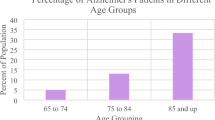Abstract
Like many diseases, dementia is associated with a changed physical structure of diseased tissue. This study is a preliminary attempt to show that these changes are detectable using image processing, and could facilitate the automated classification of dementia subtypes. The identification of a link between different pathologies and the physical structure of tissue is potentially of great benefit to our understanding of this group of diseases. We have shown the existence of such a link by applying machine learning techniques to features derived using fractal analysis, as well as classical shape parameters.
Automated classification is a common goal of machine learning, and consists of assigning a class label to a set of measurements. Classification of unlabelled samples is preceded by a learning phase, where labeled samples are presented, and the relationship between measurements and class label is determined. A variety of statistical and machine learning methods are applicable to this kind of problem, but rely on the availability of a suitable set of measurements comprising a feature vector.
Dementia is a group of diseases of which Alzheimer’s Disease (AD) is the most common, followed by Small Vessel Disease (SVD). Changes to the structure of small blood vessels in the brain have been demonstrated in both AD and SVD dementia. However, these differences are not readily apparent when viewing images obtained from these regions.
Grayscale images were obtained from prepared medical samples, comprising 18 images from the parietal (side) region, 20 images from the frontal region and 12 from the occipital (rear) region. Each image was labeled according to its pathology, i.e. Normal, AD, SVD or both AD and SVD. The branching structure of blood vessels lends itself to fractal analysis, so we calculated the. Correlation Dimension and Lacunarity for each image. These measures have not previously been applied to dementia classification.
In our first experiment, a fully crossed two fixed factor Analysis of Variance (ANOVA) was performed to test for differences between pathologies. The results of these tests found no evidence that the presence of different pathologies influenced the measures we used. One of difficulties of this type of study is the scarcity of suitable images of diseased brain tissue. A larger sample size may increase the power for the ANOVAs allowing a better chance of statistically detecting an effect.
In our second experiment, automated classification was attempted using five machine learning algorithms (Nearest Neighbour, Naive Bayes, Decision Tree Induction, CMAC, and Decision Table). The classification accuracy on cross validation tests was compared to that achieved using a default classifier. These results indicate that dementia subtypes can be distinguished in samples from the parietal and frontal regions. A test to indicate only the presence or absence of disease, by grouping AD, AVD and both diseases into one class, showed increased accuracy, suggesting that such differences are feasible for these measurements.
Our results suggest that dementia subtypes can be distinguished from images of cortical tissue, as long as suitable measurements are used. We also found evidence of a difference between the structure of small blood vessels from different regions of the cortex. This has implications for understanding of the causes, pathology and treatment of these diseases. Our findings demonstrate the utility of multi-fractal analysis combined with machine learning techniques in dementia research. This has implications for the understanding of this group of diseases, as well as for the analysis of cortical images in other contexts.
Access this chapter
Tax calculation will be finalised at checkout
Purchases are for personal use only
Similar content being viewed by others
Author information
Authors and Affiliations
Editor information
Editors and Affiliations
Rights and permissions
Copyright information
© 2002 Springer-Verlag Berlin Heidelberg
About this paper
Cite this paper
Jelinek, H., Cornforth, D., Waley, P., Fernandez, E., Robinson, W. (2002). A Comparison of Machine Learning Approaches for the Automated Classification of Dementia. In: McKay, B., Slaney, J. (eds) AI 2002: Advances in Artificial Intelligence. AI 2002. Lecture Notes in Computer Science(), vol 2557. Springer, Berlin, Heidelberg. https://doi.org/10.1007/3-540-36187-1_70
Download citation
DOI: https://doi.org/10.1007/3-540-36187-1_70
Published:
Publisher Name: Springer, Berlin, Heidelberg
Print ISBN: 978-3-540-00197-3
Online ISBN: 978-3-540-36187-9
eBook Packages: Springer Book Archive




